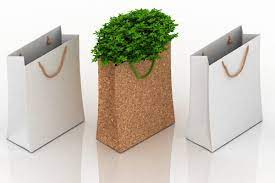Definition of Biodegradable Food Packaging: The term biodegradable is often used to describe a product that can decompose without causing any harm to the environment. While some people feel that a biodegradable product does not necessarily mean it is sustainable, many environmentalists support the usage of biodegradable packaging as a way to reduce landfill waste. This product type was first introduced to the market in the early 1990s and, at that time, did not have the same environmental impact as it does today. However, with increased awareness about the impact of packaging on the environment, and as more consumers opt to purchase foods that are packaged in such as manner, biodegradable food packaging has become an increasingly popular option. In recent years, biodegradable packaging products have grown in popularity and, as a result, the industry now stands at over $20 billion worldwide.
Types of Biodegradable Food Packaging Materials: The types of biodegradable food packaging materials currently available are cardboard and paperboard. Cardboard is the most environmentally friendly of these products, as its digestion process decreases its carbon footprint (from burning trees to make cardboard) by almost fifty percent. However, it does not decompose completely, and so releases methane gas during digestion, which has a negative impact on the environment. By comparison, paperboard releases methane, but only slightly more than that of cardboard. As well as being significantly more economical and environmentally responsible, paperboard is also easily recycled.
Benefits of Utilising Biodegradable Food Packaging: Although a biodegradable product may not be as appealing as traditional packaging, biodegradable food packaging does provide additional benefits to consumers. Firstly, they offer a range of advantages over traditional packaging: they are lighter and more flexible, which means that they can be used to pack any type of food, including dairy produce, fish and meat products, even biscuits! Secondly, they are easy to clean and therefore reduce odours – if biodegradable packaging was used instead, we would all be breathing in that nasty chemical smell. Thirdly, they are easily disposable and can be thrown away after use, unlike paperboard which has to be kept in special storage bags or boxes, making it an environmentally unfriendly product. Fourthly, they are more cost effective than most alternatives.
How to Recycle biodegradable food packaging: It is not always feasible to simply recycle your plastics. One of the key strategies is to implement systems where plastics are composted, rather than directly thrown away. A great way to do this is to join a Responsible Plastic Recycling Scheme. With such a scheme, a company will recycle the plastics it produces, so giving you, the consumer, greater choice when buying biodegradable packaging.
How to Make the Most from Eco Friendly Food Packaging: If you buy biodegradable food packaging, ensure that the label also contains an ‘Eco Label’. This certification, issued by the government, allows you to know exactly how much exactly is being used in producing your product. It highlights the fact that these types of products are bio-degradable materials and therefore help to protect the environment. The certification is especially important for products containing plastic, since there are no standard guidelines to adhere to, and can mean that the amount of plastic allowed in by the government may well be lower than safe.
Why is Eco-Friendly Food Packaging Good For the Environment? As well as helping to reduce the impacts on the environment, the use of eco-friendly packaging helps to improve the quality of our lives. As our consumerism becomes more focussed on preserving resources, we are all recognising that the use of plastic is detrimental to our health – in particular, the impact on our marine life. As a result, consumers are embracing more eco friendly alternatives, including biodegradable food packaging, which is particularly good news for the sea life that will be affected. Not only that, but biodegradable packaging can be repurposed as a way of recycling plastic, making it easier for manufacturers to reuse plastic once their packaging has been consumed.

